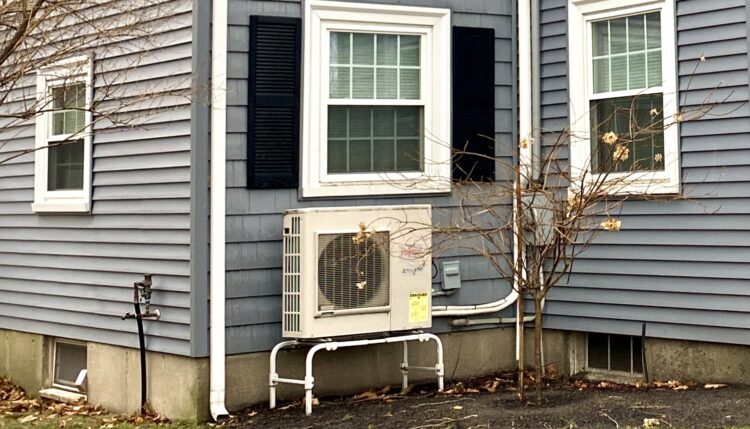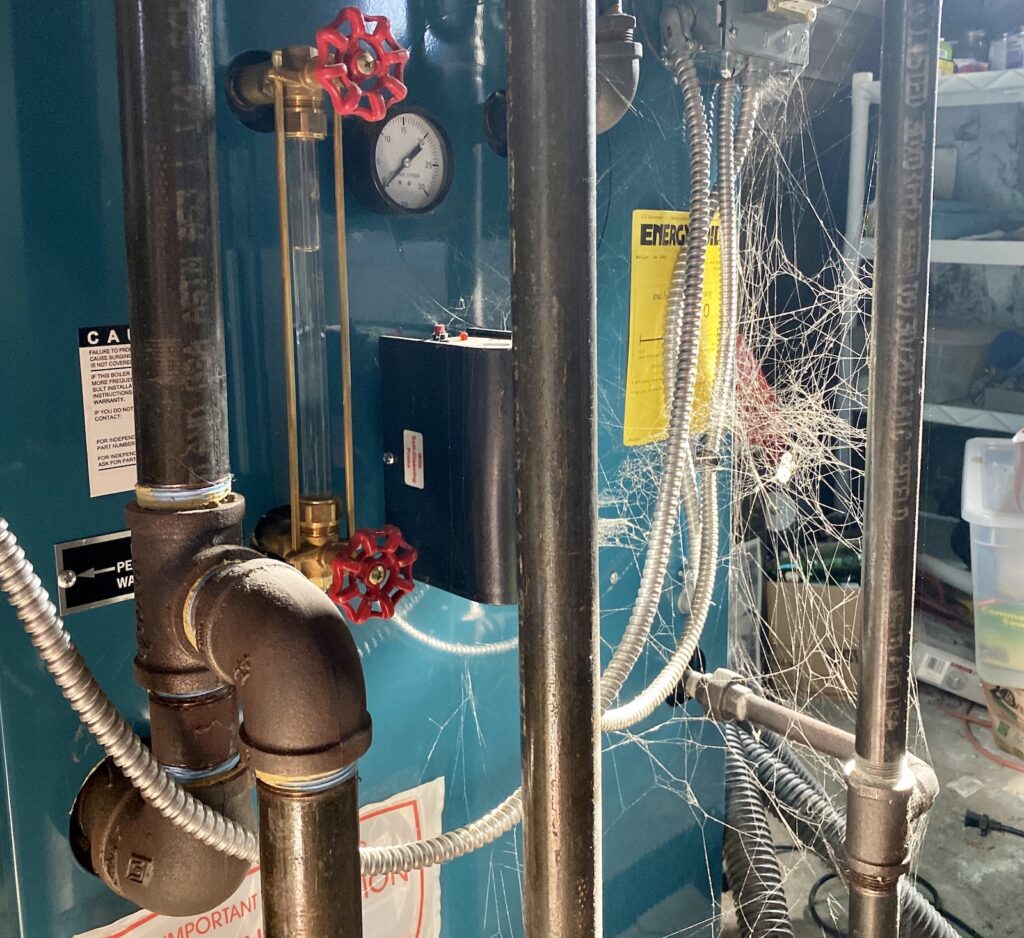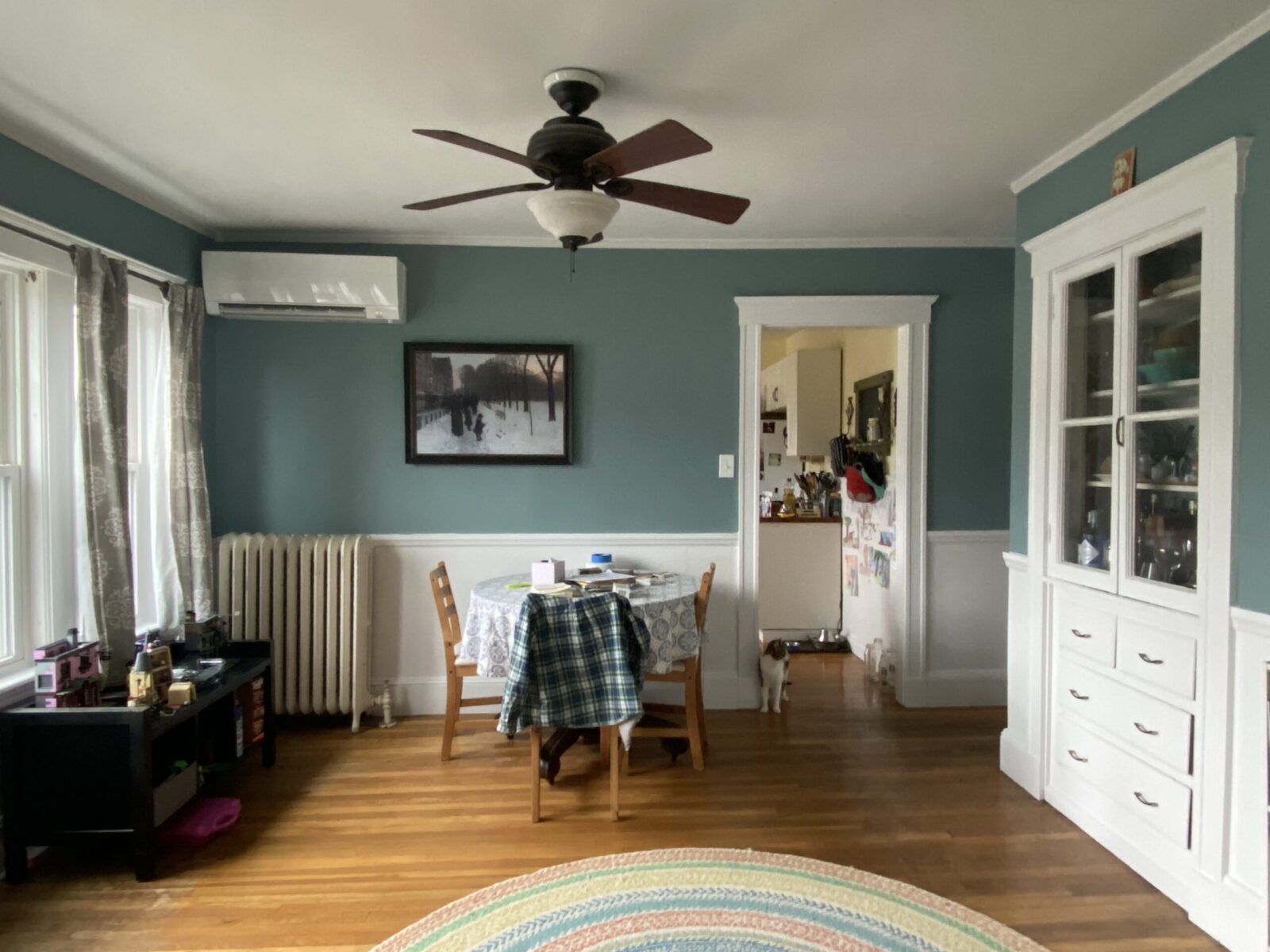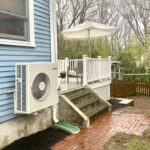We installed a mini-split heat pump in our home in 2021 — not a whole-home system, just one wall-mounted unit in the living area, because that was all we could…

Step by step: Converting from an oil furnace to electric heat pump before winter
It’s hard to think about heating oil in the midst of the hottest 21-day period in Boston’s recorded history. But while gas prices started dipping downward the past month, the cost of heating oil in Massachusetts is still up 72% compared to a year ago, at around $5 a gallon. That could leave many New England residents struggling to stay warm this winter.
If you’d like to get your home off of oil heat, the secret isn’t a gas heat conversion. Gas, after all, is also going to be expensive this winter (not to mention climate-wrecking). Nope, the secret is converting from an oil furnace to an electric heat pump.
I’ve researched, talked about, and written about heat pumps and mini-splits at length. Last year we even installed one ourselves. I can tell you that they’re pretty amazing!
And despite what you may have heard, a cold-weather heat pump can keep a New England home warm all winter long.
Pros of a heat pump
Heat pumps are incredibly efficient. Because they simply move heat instead of creating it through combustion, air-source heat pumps operate at up to 300% efficiency. (The most efficient gas boilers and furnaces top out at around 95%.)
It’s electric (boogie-woogie). This is important because electrification is the key to de-carbonizing our homes, which we need to do if we don’t want this kind of heatwave hellscape to become just plain “summer.” Our electricity mix in Massachusetts is now 59% carbon-free and getting greener every year — it’s required to, by law. And if you sign up for 100% renewable electricity through the Green Energy Consumers Alliance, you can heat your home carbon-free right now. What’s more, if you have solar panels installed, you can basically heat your home for free.
It’s also an air conditioner. One of the coolest things about a heat pump has nothing to do with heat. A mini-split system is a great way to get central air in a house without ductwork (i.e., baseboard or radiator heat). This is our first summer with our heat pump, and the difference in comfort is STAGGERING. It’s whisper quiet, the house is cool and dry despite the hot soup outside, and it uses way less energy that the three window AC units we used to rely on.
There are huge rebates and tax credits. New in 2022 (too late for us unfortunately), MassSave is offering monster rebates on heat pump installations. That includes a $10,000 refund on a whole-home heat pump system (meaning you replace your oil or gas furnace with an electric heat pump). But even partial installations and mini-splits qualify at $1,250 per ton. So a pair of 18,000 BTU mini-splits would still come with a $3,750 rebate. Meanwhile, the Inflation Reduction Act created a 30% tax credit on heat pumps, up to $2,000 per year.
You can reclaim basement or chimney space. Heat pumps come in two parts, with the main component sitting outside (like a central air conditioner). Inside, you might have a compressor that pushes the conditioned air through a series of vents, or wall-mounted blower units. But neither is so big as an oil furnace, and none of it needs chimney venting. That means you can potentially reclaim space in your basement, or even remove an old chimney in favor of a new closet.
| I wrote a book! It’s called ‘Home Buying 101: Your Essential Guide to Buying Your First Home‘ and you can get it from Amazon, Bookshop.org, Barnes & Noble, or your local bookstore. |  |
Cons of a heat pump
It’s not a ‘bone-soaking’ heat. Heat pump heat feels like that of a climate-controlled office building — it’s a very even heat, if that makes sense. If you have a furnace right now with forced hot air, you probably won’t notice a difference. But if you’re accustomed to the cozy clanging of 200-degree steam radiators, as we are, it’s not quite the same. When we craved that kind of bone-deep, cozy warmth last winter, we would light a fire in our wood stove. (It’s basically a big cast-iron radiator once it heats up.)
Heat pumps do lose some efficiency below freezing. But modern cold-weather heat pumps, like Mitsubishi’s Hyper Heat models, are still 100% efficient down to 0º F — still more efficient than the best gas boiler or furnace — and continue to provide heat at 75% efficiency all the way down to –13ºF. For context, Boston averages just one night a year when the mercury dips to 0ºF.
Ready to make the switch? You’ll want to get the ball rolling soon, because the whole process can take two or three months. Here’s a step by step guide to getting a heat pump or mini-split in Massachusetts:
Step 1: Get insulated.
Heat pumps work great, even in the cold. But if you’re losing half the heat they’re pumping in through leaks in your attic or walls, it’s going to erase a lot of your savings and create chilly-feeling drafts due to the air movement.
It’s essential to button up your house by sealing any air leaks and adding insulation in the attic (top priority), basement and rim-joists, and walls.
Most Massachusetts residents can get a lot of this done at a 75% discount or even for free through the Mass Save program. In fact, renters and landlords can get 100% of the cost covered for air sealing and insulation if every unit in the building signs up at the same time.
First, schedule a free energy audit with Mass Save. A home efficiency expert will come out and evaluate your insulation needs. They’ll explain the various hoops you have to jump through — choosing a contractor, sending in a signed contract, etc. — and then you’re on your way.
We had insulation blown into our walls through Mass Save, and while it wasn’t a silky smooth process by any means, we definitely shaved about 20% off our heating bill.
Step 2: Find heat-pump savvy installers, and get 2-3 quotes.
Many HVAC pros remain either inexperienced with or skeptical of heat pumps, only viewing mini-splits as a cooling solution. So you need to find a plumber or HVAC company with plenty of experience installing the technology — someone who understands how to make it heat your home, not just cool it.
The simplest, slam-dunk heating-oil-to-heat-pump-conversion is when you have a forced-air furnace with ductwork already in place. In that case, you can generally just swap out the oil furnace with a full-size electric heat pump. You can use the existing ductwork to heat your house (and to cool it, too).
A heat pump will cost more than a new furnace would, but not a whole lot more. And it’ll give you air conditioning to boot, and cost less to operate. And in addition to getting up to $10,000 in Mass Save rebates, you can pay for it with a seven-year, 0% APR Heat Loan as well.
But if you have radiators, or want to keep your furnace or boiler and simply augment it with a heat pump, there are many configurations you can use. So you want an HVAC pro who can think practically and creatively about how to best employ the technology in your house.
Our home, for example, is a traditional two-decker with steam radiator heat (no ductwork). Our upstairs unit has an open living and dining area, plus a kitchen, bath, and three bedrooms. To get complete, even coverage — a ceiling vent or a wall unit in every bedroom, the kitchen, and the main living and dining area — we were quoted an astronomical cost of about $27,000. That would have entailed having the main outdoor unit run either to a compressor in the attic, where they would have had to install a system of ducts and vents to five or six rooms, or to five separate interior wall-mounted mini-splits. Expensive and complicated.
Instead, we ended up just getting one 21,000 BTU mini-split wall unit in the open living and dining room. We sleep with our doors open, so the warm air circulates. It’s about 3-5 degrees colder in the bedrooms, but we find that’s actually nice for sleeping. And while we were mainly hoping just to get through the shoulder seasons (Oct/Nov and March/April) with AC in summer, we used the heat pump all winter long. In fact, we only turned on our gas heat for a couple of the most frigid January days.

We did the same on the lower level, which has the same layout but only two bedrooms. In the future, I might install a second heat-pump unit on the bedroom side of the house. Then we could run vents through the basement into each bedroom, allowing us to fully ditch gas heat.
You can find a Mass Save-approved heat pump installer by ZIP code here, or check out this full list of Mass Save-approved heat pump installers, who have been trained in correct sizing and design. That’s no guarantee that they’ll know what they’re doing or give you a good price, of course — but it’s something.
Better yet, consult this list of MassCEC heat pump installers, who participated in the agency’s successful whole-home heat pump pilot program.
Step 3: Go electric.
Depending on your home and the size of your heat pump system, you may need to upgrade your electric service. At the very least, your installer will probably have an electrician come to run a devoted line to your heat pump. We have basic, 100-amp electric service and didn’t need a panel upgrade (though we will to install a car charger).
Our installation took about three days total, and most of the work was outside and unobtrusive. They placed the indoor blower unit near an exterior wall, so the AC condensate can drain via gravity. That eliminated the need for an electric drain pump, which would have added cost and complexity.
And then, voila! A slim, push-button remote now controls the climate in here. (You can mount its case to the wall to turn it into a thermostat.) It’s whisper quiet, surprisingly powerful, and, because we use solar and renewable energy, pretty much carbon-free.

Now, one warning for you: Your electric bill will go up big time as heating season hits! I was initially shocked by this. But then I compared the increase to our gas bill during heating season… and it was quite a bit less! Even after accounting for heating degree days, the electric heat pump cost less to operate than our gas boiler. (Heating degree days are a measure of how far the outdoor temperature deviated from 65ºF each day.)
Extra credit: Go carbon-free.
Here’s a fun bonus to converting an oil furnace to an electric heat pump. Instead of paying $5 a gallon for heating oil — that’s $1,250 to fill up a typical 250-gallon tank — you can now heat your home for free if you’re able to install enough rooftop solar panels to offset most or all of your electricity use.
But even if your home isn’t a good fit for solar, you can source 100% renewable energy for your new heat pump. You can enroll in community solar program through Energy Sage, and/or sign up for clean energy through the Green Energy Consumers Alliance if you live in Massachusetts or Rhode Island. I ran the numbers after two winters, and found that simply using our heat pump as a supplemental heat source reduced our carbon output by nearly 4 tons a year — more than if we stopped driving completely!
By converting to an electric heat pump, you’ll be doing your part to end our fossil fuel addiction. And, with summers only getting hotter, you’re sure to appreciate its cooling capabilities too.



